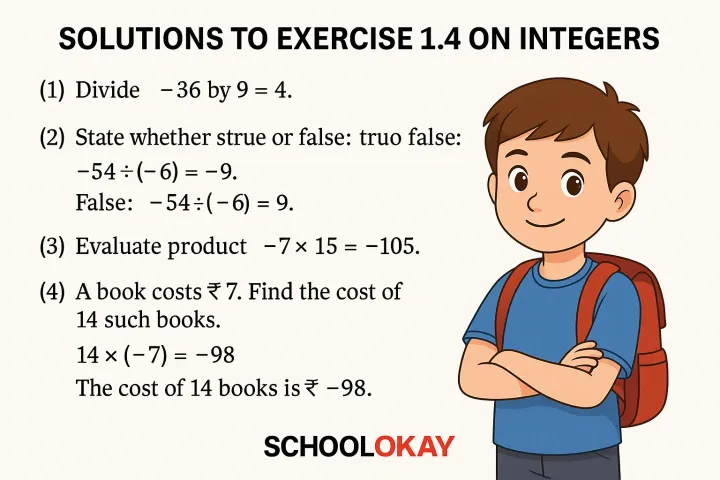NCERT Solutions for Class 7 Maths Chapter 1 Integers, Exercise 1.2.
NCERT Solutions for Class 7 Maths Chapter 1 Integers, Exercise 1.2. This exercise focuses on the multiplication of integers and related.

Below are the solutions for NCERT Solutions for Class 7 Maths Chapter 1 Integers, Exercise 1.2. This exercise focuses on the multiplication of integers and related properties.
Exercise 1.2: NCERT Class 7 Maths Chapter 1 Integers
Question 1: Find each of the following products:
(a) 3 × (-1)
(b) (-1) × 225
(c) (-21) × (-30)
(d) (-316) × (-1)
(e) (-15) × 0 × (-18)
(f) (-12) × (-11) × (10)
(g) 9 × (-3) × (-6)
(h) (-18) × (-5) × (-4)
(i) (-1) × (-2) × (-3) × 4
(j) (-3) × (-6) × (-2) × (-1)
Solution:
(a) 3 × (-1) = -3
(b) (-1) × 225 = -225
(c) (-21) × (-30) = 21 × 30 = 630
(d) (-316) × (-1) = 316
(e) (-15) × 0 × (-18) = 0 (any product with 0 is 0)
(f) (-12) × (-11) × (10) = (12 × 11) × 10 = 132 × 10 = 1320
(g) 9 × (-3) × (-6) = (9 × 3) × 6 = 27 × 6 = 162
(h) (-18) × (-5) × (-4) = (18 × 5) × 4 = 90 × 4 = 360
(i) (-1) × (-2) × (-3) × 4 = (1 × 2 × 3) × 4 = 6 × 4 = 24
(j) (-3) × (-6) × (-2) × (-1) = (3 × 6) × (2 × 1) = 18 × 2 = 36
Question 2: Verify the following:
(a) 18 × [7 + (-3)] = [18 × 7] + [18 × (-3)]
(b) (-21) × [(-4) + (-6)] = [(-21) × (-4)] + [(-21) × (-6)]
Solution:
(a) LHS: 18 × [7 + (-3)] = 18 × (7 - 3) = 18 × 4 = 72
RHS: [18 × 7] + [18 × (-3)] = 126 + (-54) = 126 - 54 = 72
LHS = RHS (Verified)
(b) LHS: (-21) × [(-4) + (-6)] = (-21) × (-4 - 6) = (-21) × (-10) = 210
RHS: [(-21) × (-4)] + [(-21) × (-6)] = (21 × 4) + (21 × 6) = 84 + 126 = 210
LHS = RHS (Verified)
Question 3:
(i) For any integer ( a ), what is (-1) × ( a ) equal to?
(ii) Determine the integer whose product with (-1) is:
(a) -22
(b) 37
(c) 0
Solution:
(i) (-1) × ( a ) = -( a ) (Multiplying any integer by -1 gives its negative.)
(ii) Let the integer be ( x ).
(a) (-1) × ( x ) = -22 → ( x ) = 22
(b) (-1) × ( x ) = 37 → ( x ) = -37
(c) (-1) × ( x ) = 0 → ( x ) = 0
Answers:
(i) -( a )
(ii) (a) 22, (b) -37, (c) 0
Question 4: Starting from (-1) × 5, write various products showing some pattern to show that the product of a negative integer and a positive integer is a negative integer.
Solution:
Consider the pattern:
(-1) × 5 = -5
(-1) × 4 = -4
(-1) × 3 = -3
(-1) × 2 = -2
(-1) × 1 = -1
Alternatively:
(-2) × 3 = -6
(-3) × 2 = -6
(-4) × 1 = -4
Pattern: The product of a negative integer and a positive integer is always negative.
Question 5: Find the product, using suitable properties:
(a) 26 × (-48) + (-48) × (-36)
(b) 8 × 53 × (-125)
(c) 15 × (-25) × (-4) × (-10)
(d) (-41) × 102
(e) 625 × (-35) + (-625) × 65
(f) 7 × (50 - 2)
(g) (-17) × (-29)
(h) (-57) × (-19) + 57
Solution:
(a) 26 × (-48) + (-48) × (-36) = (-48) × [26 + (-36)] (Distributive property)
= (-48) × (26 - 36) = (-48) × (-10) = 480
(b) 8 × 53 × (-125) = (8 × 125) × (-53) (Commutative and associative properties)
= 1000 × (-53) = -53000
(c) 15 × (-25) × (-4) × (-10) = (15 × (-25)) × ((-4) × (-10))
= (-375) × 40 = -15000
(d) (-41) × 102 = (-41) × (100 + 2) (Distributive property)
= (-41) × 100 + (-41) × 2 = -4100 - 82 = -4182
(e) 625 × (-35) + (-625) × 65 = 625 × (-35) - 625 × 65
= 625 × [(-35) - 65] (Distributive property)
= 625 × (-100) = -62500
(f) 7 × (50 - 2) = 7 × 50 - 7 × 2 (Distributive property)
= 350 - 14 = 336
(g) (-17) × (-29) = 17 × 29 = 17 × (30 - 1)
= 17 × 30 - 17 × 1 = 510 - 17 = 493
(h) (-57) × (-19) + 57 = 57 × 19 + 57 = 57 × (19 + 1) (Distributive property)
= 57 × 20 = 1140
Question 6: A certain freezing process requires that room temperature be lowered from 40°C at the rate of 5°C every hour. What will be the room temperature 10 hours after the process begins?
Solution:
Initial temperature: 40°C
Rate of decrease: 5°C per hour
After 10 hours: Temperature decreases by 5 × 10 = 50°C
Final temperature: 40 - 50 = -10°C
Answer: -10°C
Question 7: In a class test containing 10 questions, 5 marks are awarded for every correct answer and (-2) marks are awarded for every incorrect answer and 0 for questions not attempted.
(i) Mohan gets four correct and six incorrect answers. What is his score?
(ii) Reshma gets five correct and five incorrect answers. What is her score?
(iii) Heena gets two correct and five incorrect answers out of seven questions she attempts. What is her score?
Solution:
(i) Mohan:
Correct: 4 × 5 = 20 marks
Incorrect: 6 × (-2) = -12 marks
Total score: 20 + (-12) = 20 - 12 = 8
(ii) Reshma:
Correct: 5 × 5 = 25 marks
Incorrect: 5 × (-2) = -10 marks
Total score: 25 + (-10) = 25 - 10 = 15
(iii) Heena:
Correct: 2 × 5 = 10 marks
Incorrect: 5 × (-2) = -10 marks
Total score: 10 + (-10) = 10 - 10 = 0
Answers:
(i) 8 marks
(ii) 15 marks
(iii) 0 marks
Question 8: A cement company earns a profit of ₹8 per bag of white cement sold and a loss of ₹5 per bag of grey cement sold.
(i) The company sells 3000 bags of white cement and 5000 bags of grey cement in a month. What is its profit or loss?
(ii) What is the number of white cement bags it must sell to have neither profit nor loss, if the number of grey bags sold is 6400 bags?
Solution:
(i) Profit on white cement: 3000 × 8 = ₹24000
Loss on grey cement: 5000 × (-5) = -₹25000
Total: 24000 + (-25000) = 24000 - 25000 = -₹1000 (Loss)
Answer: Loss of ₹1000
(ii) Grey cement loss: 6400 × (-5) = -₹32000
Let ( x ) be the number of white cement bags.
Profit on white cement: ( x \times 8 = 8x )
For no profit or loss: ( 8x + (-32000) = 0 )
( 8x = 32000 )
( x = 32000 / 8 = 4000 )
Answer: 4000 bags
Question 9: Replace the blank with an integer to make it a true statement:
(a) (-3) × ___ = 27
(b) 5 × ___ = -35
(c) ___ × (-8) = -56
(d) ___ × (-12) = 132
Solution:
(a) (-3) × ( x ) = 27 → ( x = 27 / (-3) = -9 )
(b) 5 × ( x ) = -35 → ( x = -35 / 5 = -7 )
(c) ( x ) × (-8) = -56 → ( x = -56 / (-8) = 7 )
(d) ( x ) × (-12) = 132 → ( x = 132 / (-12) = -11 )
Answers:
(a) -9
(b) -7
(c) 7
(d) -11
Here are other exercises.

Share with others.





Comments ()